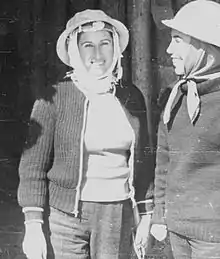Shulamit Gross
Shulamit Gross (Hebrew: שולמית גרוס; lived 1 October 1923 – 19 Sep 2012) was an Israeli mineralogist and geologist who studied the Hatrurim Formation.
Shulamit Gross | |
|---|---|
 | |
| Alma mater | Belarusian National Technical University |
| Known for | Hatrurim Formation |
| Scientific career | |
| Institutions | Hebrew University of Jerusalem |
Biography
Gross was born as Shulamit Lifszyc in Grodno, Poland (today, Hrodna, Belarus).[1] She was the daughter of Fryda and Mejer Lifszyc. She studied in the local Tarbut school, and later on at the Belarusian State Polytechnic Institute in Minsk.[1] When Nazi Germany invaded the Soviet Union during the summer of 1941, she fled to Tashkent in Uzbekistan.[1] Here she continued her studies in the faculty of geology, which she graduated cum laude in 1945.[1] Her parents died in the Treblinka extermination camp in 1943.[1] She began a PhD in the Radioactive Micas of Central Asia, but was not permitted KGB security clearance, and her studies were terminated.[1] After graduating, she moved to Lomonosov University in Moscow to conduct research in crystallography.[1] Her second project considered "The ionic radius affect on lattice structure and mineral properties”.[1] In 1950 she immigrated to Israel (Aliyah) with her husband, the film director Natan Gross, and their baby, Yaakov, who later became a film director in his adult life as well.
Research

Gross was known for her research on the mineralogy of the Hatrurim Formation. In 1958 she began working at the Israel Atomic Energy Commission.[1] During the 1960s, a group of scientists from the Hebrew University of Jerusalem, including Yaakov Ben-Tor, and Lisa Heller-Kallai, discovered the unique mineral assemblage found in the Hatrurim Formation. She moved to the Israeli Geological Society in 1961.[1] She became a PhD candidate at the Hebrew University of Jerusalem in 1964, working on "The Mineralogy of the Hatrurim Formation, Israel".[1]
A mineralogical analysis revealed that the rocks contain common minerals such as diopside, wollastonite, garnet, anorthite, as well as rare minerals such as spurrite, brownmillerite, gehlenite, and larnite.[1][2] These rare minerals only form at high temperatures, for example in places where siliceous limestones are contact-metamorphosed by volcanic rocks (commonly basalt). These minerals are also common in man-made Portland cement, used in the construction industry. The manufacturing of Portland cement involves a similar process: heating of limestone or chalk with siliceous clay at high temperatures (1300 °C).
She continued to study the minerals and in 1977 published a monograph describing 123 mineral species discovered in the Hatrurim Formation.[1][3] Five were previously known only from a single locality, and eight others were known only as synthetic products of the cement industry. Gross also discovered several minerals completely new to science: bentorite, ye’elimite, and hatrurite.[2][4][5][6] A fourth mineral discovered by Gross was only described later by Dietmar Weber and Adolf Bischoff, which they named grossite after Shulamit.[1][7][8]
She demonstrated that the unique mineral assemblage of the Hatrurim Formation formed by pyrometamorphism, and she managed to recreate most of the minerals by heating the precursor sedimentary rocks of the Ghareb and Taqiye formations.
Her discoveries earned her the inaugural Rafael Freund Award of the Israeli Geological Society in 1979.[1][9] She became an honorary member of the Israel Geological Society in 1986.[1] An additional mineral discovered in the Hatrurim Formation was named shulamitite in 2011.[10][11] She died on September 18, 2012.[1]
References
- Weiss-Sarusi, Keren (2016). "Petrographic atlas of the Hatrurim Formation" (PDF). Geological Survey of Israel. Retrieved 2018-08-01.
- journal, SCIENCE First Hand. "Reflections of Eternal Flames". SCIENCE First Hand. Retrieved 2018-08-01.
- Gross, Shulamit (1977). The Mineralogy of the Hatrurim Formation, Israel. Geological Survey of Israel.
- "The Bentorite Mineral | Mineralogy and Petrology Collection". nnhc.huji.ac.il. Retrieved 2018-08-01.
- "Bentorite: Bentorite mineral information and data". www.mindat.org. Retrieved 2018-08-01.
- "Shulamitite & Ye'elimite". e-rocks.com. Retrieved 2018-08-01.
- Barthelmy, Dave. "Grossite Mineral Data". webmineral.com. Retrieved 2018-08-01.
- Weber, Dietmar; Bischoff, Adolf (1994). "Grossite (CaAl4O7) - a rare phase in terrestrial rocks and meteorites". European Journal of Mineralogy. 6 (4): 591–594. doi:10.1127/ejm/6/4/0591.
- "list of Rafael Freund Award recipients". Israel Geological Society.
- Victor V Sharygin, Biljana Lazic, Thomas M Armbruster, Mikhail N Murashko, Richard Wirth, Irina O Galuskina, Evgeny V Galuskin, Yevgeny Vapnik, Sergey N Britvin, Alla M Logvinova (2012). "Shulamitite Ca3TiFe3+AlO8 – a new perovskite-related mineral from Hatrurim Basin, Israel". European Journal of Mineralogy. 25 (1): 97–111. Bibcode:2013EJMin..25...97S. doi:10.1127/0935-1221/2013/0025-2259.CS1 maint: uses authors parameter (link)
- "Shulamitite: Shulamitite mineral information and data". www.mindat.org. Retrieved 2018-08-01.